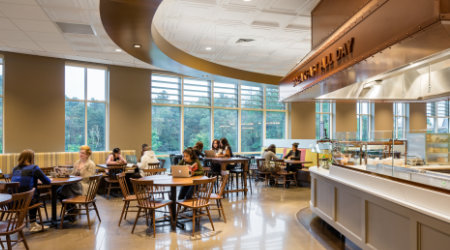
CASE STUDY: Ceiling Creates Intimate, Inviting Dining Hall
April 20, 2021
A student cafeteria doesn’t have to feel like a student cafeteria. The new Student Dining Commons at Mount Holyoke College – a 1000-seat, state of the art, anytime dining center created by Boston design firm Bergmeyer – is intended to offer an inviting, personal experience that evokes some of the school’s long tradition of intimate dining rooms.
An important element of that effect is an unusual ceiling. It features thermoformed ceiling panels from Ceilume – which meet the strict standards for food service areas and provide visual elegance to elevate the design – combined with conventional flat mineral fiber panels that are used over seating areas around the periphery. The transition between these two types of ceilings is an intermingled effect that helps lead diners from the food service to seating, while also helping to break the large volume of the space into more intimate areas.
The newly constructed Dining Commons is joined to a 19th century gym building that underwent major renovation to create a student center. Bringing all the students to eat together in one central location represented a significant cultural shift for the college, which previously had a dining hall in each dorm. The college studied the idea for 10 years before proceeding.
“We wanted it to be a place where students felt comfortable,” says Krista Easterly, interior designer at Bergmeyer.
The designers sought a look reminiscent of residential settings rather than commercial design. They wanted a ceiling with a sense of style, a coffered look.
Thermoformed Ceilume ceiling panels, made from lightweight rigid vinyl and available in a variety of 3-dimensional patterns, offered a solution that met the codes for foodservice areas, and were more affordable than plaster, wood or mineral fiber coffers. The Ceilume panels drop into standard 2x2-foot or 2x4-foot ceiling suspension grids, and allow access to the above ceiling cavity.
Instead of projecting downward, the molding is recessed into the ceiling, creating a shape that looks very similar, yet shifts how shadows and highlights play across the ceiling and enlivens the overall effect. Exact placements were decided during construction, since the panels are easy to move and not subject to damage.
The different types of ceiling panels are blended together through a “gradated” transition.
“We tried to make it look organic,” says Easterly.
They concentrated the panels over the foodservice areas, the salad bar and the deli.
“That ceiling needs to be cleanable,” says Easterly, “so it was good that it is a washable panel.”
The thermoformed panels extend over the first adjacent zones of seating and then disperse outwards, giving way to the flat panels.
Achieving acoustical control was no problem, either, despite the hard-polished concrete floors and floor-to-ceiling glass walls. The panels, which naturally dampen noise by leveraging the viscous mass of air in the above-ceiling cavity, were installed with acoustic blankets on the upper surface for additional control.
“The noise level is pretty good,” Easterly says.
The Dining Commons was designed to meet LEED Silver standards. Panels are Greenguard Gold certified and can contribute to LEED credits for acoustics, low emitting materials, and indoor air quality. Both the panels and acoustic blankets are free of frangible mineral fibers that are known to contribute to respiratory problems.
The Mount Holyoke College Dining Commons received an award for Outstanding Design from American School & University magazine and has apparently achieved its goal of creating an inviting place for students.
“It’s been wildly successful,” Easterly says. “They’re selling more meals than they ever imagined."
Next
Read next on FacilitiesNet












